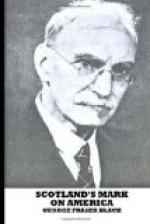John Baine, born in St. Andrews, in partnership with his grandson, established the first type-foundry in Philadelphia in 1787. Their firm cast the types for a portion of the American edition of the Encyclopaedia Britannica, reprinted in Philadelphia in 1791. Archibald Binny, (1763-1838), born in Portobello, near Edinburgh, and James Ronaldson (d. 1841), also born in Scotland, succeeded to and carried on the business established by Baine. In 1797 they cast the first $ sign used in this country. The quality and art of their product was in no wise inferior to the European and the sale of foreign made types ceased shortly after they established their business. Their foundry kept pace with the growth of the country and in the seventies of last century became the best and most extensive letter-foundry in the world. Archibald Binny loaned the United States Government the sum of 50,000 dollars for use in the war of 1812-14. Ronaldson was first president of the Franklin Institute in Philadelphia (1824-41), an institution in which he took a great interest, and in 1831 presented to Philadelphia the beautiful cemetery bearing his name. He was described as “an upright, frugal and honest man, and a lover of his adopted country.” George Bruce (1781-1866), born in Edinburgh, along with his brother David introduced the art of stereotyping, the secret of which David secured in Edinburgh. In 1816 they purchased a foundry for type making and stereotyping, and George Bruce in his seventy-eighth year of age produced type which has rarely been excelled for beauty of design and neatness of finish. “He did much toward facilitating American printing and towards making it a fine art, inventing, with the assistance of his nephew, David Bruce, Jr., a successful type-casting machine which has come into general use.” Thomas Mackellar (1812-1899), printer and poet, also one of the leading type founders, was of Scottish parentage. William Vincent McKean, born in 1820 of Ulster Scot descent, was another distinguished type-founder and editor-in-chief of the Philadelphia Public Ledger for many years. Another individual who may be included under this head is Adam Ramage who was born in Scotland and died at an advanced age in Philadelphia in 1850. He was distinguished as a manufacturer of printing presses in the beginning of last century, and patented the “Ramage” press in 1818.




